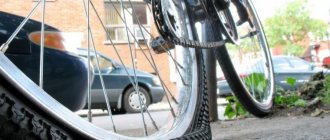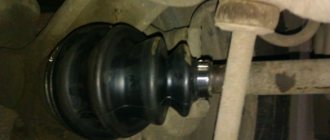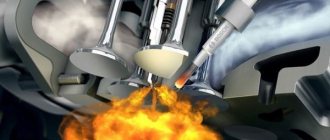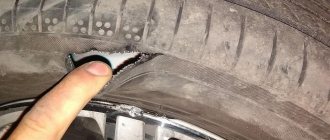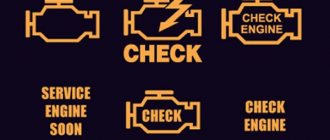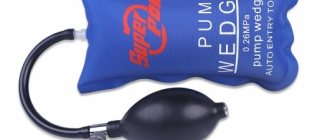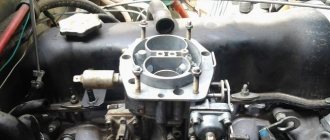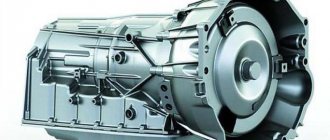How does this happen?
Similar phenomena can occur in a variety of cars - and it doesn’t matter what brand the car is or in what country it was produced.
Extraneous vibrations in the steering system are felt when driving at speeds up to 70 km/h. But this happens in different ways - on some, at speeds up to 10 km/h, vibrations are not felt, but starting from 20 km/h, the beats are already quite noticeable. If you accelerate the car to 100 km/h, they disappear completely. If the steering wheel shakes at low speeds, and the quality of the roads is frankly poor, driving such a car will greatly irritate the driver. All those who have encountered such vibrations claim that even at low speeds it becomes very difficult to hold the steering wheel.
How can you solve the problem?
Some will take their favorite car to a service station. However, this should only be done when there is a reliable specialist who knows his job well. Otherwise, there is simply no guarantee that the source of vibration will be detected and the problem will be solved. Even in the event of such troubles (and they occur very often), repair specialists can charge a high price for the work. The driver may also pay for unnecessary operations. For example, a service station offers to replace the entire steering mechanism completely. Doing this is much easier than figuring out why the steering wheel shakes at low speed. The owner should be well aware of the reasons for this behavior - then he will not need the help of the service. You can almost always fix the problem yourself.
Tire defect
Causes of steering wheel wobble include tire problems. That is, if it has any defect that was not noticed at the factory, or the defect was acquired during operation, then vibration will be constantly felt. In this case, the problem can be solved with the help of tire fitting, and if it cannot be eliminated, then by replacing the tire.
The steering wheel may jerk at speed due to insufficient fastening of the disc itself to the hub. For example, if the nuts are loosely tightened. Every driver can make such an oversight, but it needs to be corrected as quickly as possible.
Improper wheel balancing due to mud or snow
This is one of the most popular causes of beating in the steering wheel and vibrations of the entire car. The root of the problem is this. Dirt or snow may become clogged in the wheel rim - in this case, vibrations may occur temporarily. If there are problems with balancing due to dirt, the beating will begin when driving at low speeds, and may disappear during acceleration.
Diagnosing this problem is very simple in the case of alloy wheels - the dirt will be visible. If steel wheels are installed, then difficulties may arise. The design of the disk is such that the ventilation holes are small and can significantly interfere with visibility. Dirt often accumulates on the inside of the wheel.
Why does the brake pedal hit when braking? Troubleshooting instructions
Reasons why the brake pedal fails
The smooth operation of the car's braking system allows the driver not to create emergency situations when driving in traffic. Slow braking can lead to a collision with the car in front, and a sudden stop will confuse drivers behind. Drivers quickly get used to the responsiveness of the braking system, and any malfunction in it can lead to an accident. One of the problems that a person behind the wheel may encounter is the brakes squealing when braking. If the pedal squeaks when you press the brake, this problem must be addressed immediately, as it indicates a problem with the braking system.
Why does the brake pedal hit when braking?
The car's braking system is quite simple, and there are not many parts that can fail. Moreover, almost each of them can lead to the problem under consideration. If the brake pedal hits when braking, you need to check the following units:
- Brake pads. Severe wear on the brake pads can cause the brake pedal to squeal. It is necessary to check the pads for wear and determine their suitability. In this case, both front and rear pads should be diagnosed. If the thickness of the part does not meet the requirements of the brake system (or the pads have mechanical damage), it will need to be replaced. Do not forget that the pads must be changed in pairs on the same axis.
- Brake drum. When braking, the pads touch the drum. If it is damaged or deformed, vibration from their contact will be transmitted to the car body, including the brake pedal. Often the brake pads and brake drum on the rear axle of the car fail at the same time, and they will need to be replaced together to get rid of the problem.
- Brake discs. When operating a car, brake discs have to withstand severe loads associated not only with friction, but also with temperature changes. When driving in the city, you often need to press the brake pedal, which increases the temperature of the brake discs. If cold water (for example, snow) gets on them, they can become deformed under the influence of sudden temperature changes. A bent brake rotor will cause problems with braking and transmission of vibration into the pedal.
Please note: It is important to replace discs, like brake pads, in pairs on one axis. However, after replacing the disks, the problem may persist, even if all units are working properly. It is necessary to “break in” the new part a little so that the pads get used to it
It is necessary to “break in” the new part a little so that the pads get used to it.
Brake cylinders. If the brake cylinders are deformed or malfunctioning, this can cause the brake pedal to wobble. In such a situation, it is recommended to inspect the cylinders for any distortions. If they are not detected, you need to lubricate them to be sure that there are no freezes.
It is important to inspect the entire braking system when looking for the cause of brake runout. One faulty unit may cause other parts to become unusable.
The brake hits when the braking system is working properly
If the braking system has been checked, but defective elements cannot be detected, the problem may be hidden in less obvious reasons. In such situations it is recommended:
- Make sure the wheels are properly balanced. An experienced driver can easily determine that the wheels of a car are unbalanced. A clear symptom of this is the rolling of the entire body when the car is moving, and not just the beating of the brake.
- Check the front suspension arms for bending and secure fastenings.
- Check the condition of the wheel bearing. If it becomes excessively worn, it will need to be replaced.
- Make sure that the fastening of body elements, suspension, and braking system is secure. Often the cause of brake chatter is poor bolt tightening throughout the vehicle. This problem is especially relevant when driving on bad roads. Check the tightness of all accessible bolts on the vehicle.
How to avoid car brakes from squealing
If the brake pedal begins to vibrate when pressed, then this problem will not go away on its own. It is necessary to diagnose the machine as soon as possible and eliminate the malfunction. To avoid such troubles in the future, you need to follow these recommendations:
- Monitor the brake fluid level in the reservoir;
- Regularly check the brake system for leaks;
- Change the pads on time, without waiting for their maximum wear.
The braking system is nothing to joke about, and at the first symptoms of its malfunction, the problem should be eliminated.
Balancing disorders
Tires and rims are not ideal either in terms of geometric characteristics or composition. And since the weight of these elements differs in some parts, then at the moment the wheel rotates, the point where the weight is greater will pull the center of the wheel towards itself. This is the effect of centrifugal force. Even at low speeds (and already at 40 km/h the wheels rotate quite quickly), vibrations will come to the steering wheel through the rods. Wheels must be balanced. This is done after replacing tires or wheels. The essence of the process is that the mass of the wheel is the same at each point. To do this, special weights are attached to the disk.
If you drive for a long time with unbalanced wheels, this causes severe wear on the tire in certain places. These worn areas will cause even greater vibrations in the future. But that is not all. The wheel bearing and all suspension elements are subject to significant wear.
Symptoms of imbalance
The main symptoms are the steering wheel shaking at low speed. But vibrations can also be felt at higher speed ranges - from 60 km/h and above. It is necessary to carefully inspect the tires and wheels. The discs must be smooth and without deformation. If your driving style is calm and careful, and the tires are not too worn, then the cause is imbalance. What to do in this case? Balancing only the front wheels if there are vibrations only on the steering wheel is the wrong approach.
All four wheels need to be aligned. This is the only way to get the desired effect.
Why does my steering wheel vibrate?
Beating and vibration can occur both at high speed and at relatively low speed. Sometimes the hesitation, as in your case, ends at a speed of 40 km/h, and sometimes it only begins after accelerating from 100-120 km/h. But it should be noted right away that regardless of the speed barrier, steering wheel vibration is a problem that needs to be solved. So, what could this be connected with?
Vehicle steering linkage
- The wheel rim is defective or its geometry is damaged. This can happen due to manufacturing defects, regular off-road driving and huge potholes. In addition, the cause can be an ordinary bump on the tire, sometimes this manifests itself as a result of a “sledgehammer repair”. You can only find the causes and eliminate them at a tire service. This will require the use of specialized equipment.
- In practice, we often encounter the fact that the steering wheel oscillates at low speeds as a result of malfunctions in the operation of the suspension or steering system. Traction can be spoiled for various reasons. When you repair the suspension, you need to remember that the steering tip should also be changed periodically.
- The wheels may need to be balanced, or it may have been done by a non-professional. It is better to use tire fitting services with specialized equipment (stand).
- If dirt or debris is stuck to the inside of the disc, it may cause the steering wheel to vibrate. As a rule, such problems arise among motorists during the off-season period. If the dirt freezes, it may well affect movement.
- Sometimes domestic car owners, when tuning their vehicle, install wheels that in fact do not correspond to the standard characteristics of the hub. Such repairs can also lead to vibration.
If you have no experience in solving such problems, we recommend that you contact a specialist so as not to aggravate the situation.
Disc deformation
As already noted, they are far from ideal in their geometric characteristics. And how curved the wheels are greatly affects the behavior of the car. Wheel rims may become deformed due to the vehicle falling into a hole. Curvature can be detected visually. It is necessary to carefully inspect the rim for dents. But most often the inner part of the wheel rim is bent. Stamped products are most susceptible to deformation. Cast ones are destroyed to a lesser extent. The wheel rim may change its geometry during operation, or may be uneven initially. This is determined at a special stand. But there is a problem here - often on such equipment the wheel behaves correctly, but when driving a car it rotates unevenly. If the disk behaves this way, then it is clearly defective.
Tires
The steering wheel shakes when driving at low speed due to the tires, or rather their quality and condition. The cord, the metal braid that is located inside the tire, is often damaged. As a result, part of the tire becomes convex, which causes beating. Another equally popular tire problem is bumps. They appear on the sidewalls of the rubber due to careless driving, driving on potholes or rails. Well, you can’t cancel a factory defect. He can express himself in a variety of ways. If it hits the steering wheel at low speed, the problem can be solved by replacing damaged disks and tires.
Brake system elements
Most often it hits the steering wheel when braking due to problems with the system of the same name. And this can happen due to:
- DEFORMATION OF BRAKE DISCS. This is one of the most common reasons. As a result of friction with the pads, the brake disc heats up quite strongly during braking, and if it is cooled sharply (for example, water from a puddle immediately gets on it), it warps (its geometric shape is disrupted). The curvature of the working surfaces of the disc leads to runout in the pads, which is transmitted to the caliper, and from it, in turn, to the hub and steering rods. But warping of the rear brake discs or drums will turn into strong vibration of the body. The problem can be fixed either by grooving the brake discs (a method that allows work to be done without removing the element from the car) or by replacement;
- UNEVEN WEAR OF THE PADS AND THEIR DAMAGE. In this case, the runout will be caused by the uneven surface of the friction linings. Since the pads are worn in to the working surfaces of the brake discs, when replacing or turning the latter, they must be changed;
- WEDDING THE CALIPER. Often the caliper guides become stuck in their mounting holes. Because of this, the caliper will press the pads unevenly when braking and the driver will feel a beating in the steering wheel. Everything can be “cured” by disassembling the unit, cleaning and lubricating its guides and their seats.
Note that problems with the braking system often manifest themselves not only in the steering wheel, but also in the brake pedal.
Also, in the case of a jammed caliper, the car may brake unevenly (jerky).
Knowing additional symptoms can significantly narrow down the search for the causes of the malfunction.
Weak wheel fastening
This reason is very dangerous. If the wheel fastening becomes loose and the owner does not notice it in time, the wheel may fall off the hub while driving. The safety of the driver and passengers will be at risk. When the steering wheel shakes at low speed, the reasons are not sought here. But in vain. If this problem is not detected in time, then after a while the car enthusiast will come to replace discs, hubs, brake discs and much more. In this case, vibrations are noticeable even at very low speeds. The beats will be cyclical or acyclic. They can appear and disappear at the same speeds.
How is a malfunction diagnosed?
To identify the runout of one of the front wheels, you will need a jack, wheel chocks and a wheel wrench. The diagnostic procedure is as follows:
- Park the machine on level ground and pull the handbrake all the way. Additionally, secure the car with boots placed under any rear wheel.
- Jack up the front wheel until it hangs off the ground. On vehicles with front-wheel drive and all-wheel drive, be sure to move the gearshift lever to neutral.
- Rotate the suspended rim with your hands. If you feel stuck in a certain position, remove the wheel and check that the uneven disc is rubbing against the pads, causing strong vibration when braking.
The essence of the diagnosis is simple: after operation, the brake pads move back just enough to free the rotating surfaces.
The lining must be forced apart to its maximum open position. If the metal working part is bent, then when rotating the part will begin to get stuck between the pads. If the vibration does not cause the car to deviate from a straight path while driving and does not cause the steering wheel to twitch, check the suspension and chassis components. Drive the vehicle into the inspection ditch and jerk the steering rods to check for play. The performance of shock absorbers is checked by rocking the car up and down with body weight. After applying force, the machine should swing no more than 1 time.
Steering system and suspension
Heavily worn suspension elements affect the vehicle's contact with the road. This is due to the fact that ball joints, steering rods and wheel bearings have play. They lead to imbalance as the wheel rotates. Sometimes the suspension elements become deformed, as in the photo below.
If the steering wheel of a VAZ-2110 shakes at low speed, then this is due, first of all, to the tires, and then to the ball joints and tie rod ends.
If the steering wheel shakes when braking
When a car owner feels vibrations or beating only during braking, there is a high probability of believing that the problem lies with deformations or any other problems with the brake drum/disc.
Both of the above elements change their shape or become deformed due to high wear or overheating when the driver brakes for a long time and quite strongly. Deformation also occurs after heavy braking and then falling into a puddle - the disc overheats and cools down sharply. After such tests, the surface of the part will take on a wavy design. The drum will change its shape to oval. If the steering wheel shakes when driving (VAZ 2114 is no exception), then the reason is due to rough use of the car. Repair in this situation is impossible, and only replacing the worn or deformed part will help fix the problem.
About the rake
Also, the reason is hidden in the steering rack. It must be remembered that the clearances of the suspension elements themselves do not cause vibrations or beating on the steering wheel. The unfixed part becomes a catalyst. But the main problem is the wheels, and you need to start from this. The steering wheel of the VAZ-2110 also shakes at low speed due to a faulty power steering mechanism. In this case, the rack is directly connected to the rods - hence the vibrations. In this case, experienced car owners advise inserting a rubber element into the steering shaft cardan. A ball with a diameter of 22 mm made of synthetic rubber will do. But the material wears out and cracks over time. As a more durable solution, you can use a cube with a side of 20 mm from the bumper of classic VAZ models.
Summary
If you study the malfunctions, you can derive a small rating of the prevalence of causes. So, if the steering wheel of a VAZ-2114 shakes at low speed, then in the first place are problems with the integrity of the tires and rims. For many, vibrations were caused by a hernia or a crooked wheel. Then there are breakdowns in the suspension and steering mechanism. But often the problem can be solved by a simple visit to a tire shop. And to eliminate this situation, you should brake well before each large hole and be careful when passing railway tracks. A bump on the sidewall of a tire cannot be restored.
Vibrations and beats on the “ten”
These cars are no different from other models and brands. If the steering wheel shakes when driving a VAZ-2110, then the following faults are the cause. Among them are brake pads, but this happens very rarely. And most often, after replacing the pads, the problem returns again. But it would not be a bad idea to check their condition.
Among non-standard reasons, the hub may be the culprit for vibrations. In this case, it is recommended to turn it on a lathe or directly on the car using special tools.
In addition, the cause of vibrations on the steering wheel or body may be a CV joint that has simply fallen apart. In this case, beats are felt during acceleration, and when the car coasts, the vibrations disappear. At low speed there are none at all. In addition to beating, loud noise may also be heard.
